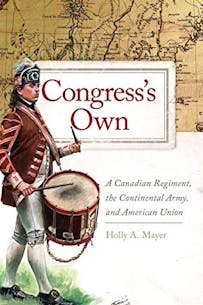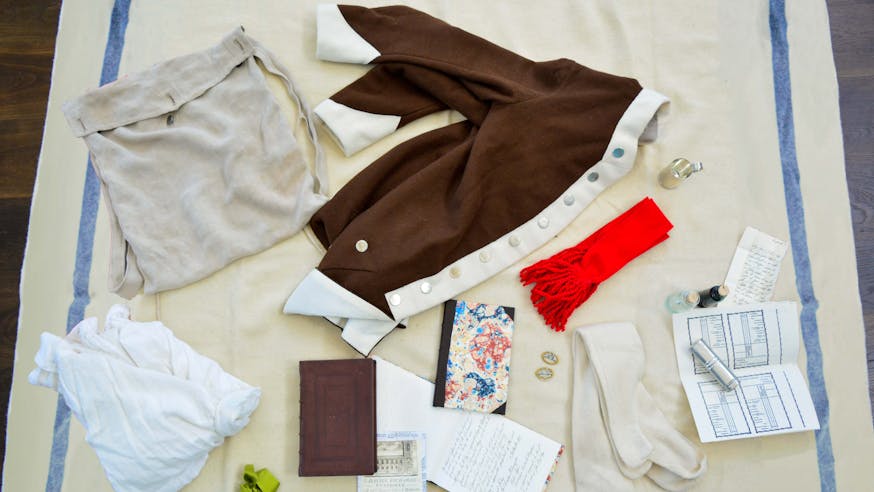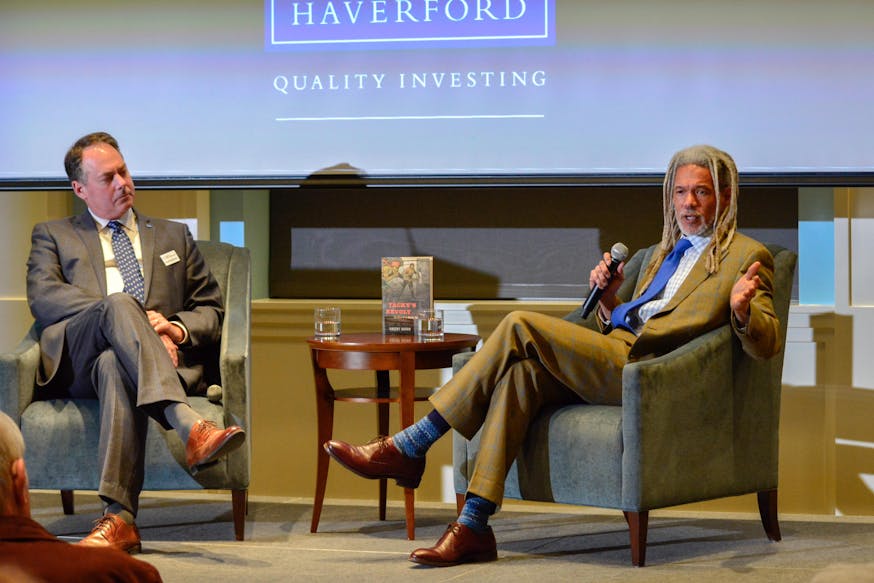Read the Revolution
Congress's Own
September 21, 2021
Purchase the book from University of Oklahoma Press.
In her latest book, Dr. Holly A. Mayer reveals what the personal passions, hardships, and accommodations of the 2nd Canadian Regiment, nicknamed “Congress’s Own,” can tell us about the greater military and civil dynamics of the American Revolution. In Congress’s Own: A Canadian Regiment, the Continental Army, and American Union, Mayer interweaves insights from borderlands and community studies with military history to explore one of the first “national” regiments created by the Continental Congress in 1776, which drew members from Canada, 11 American states, and foreign forces.
One member of the regiment was Sergeant John H. Hawkins, who wrote meticulous accounts of his experience serving with Congress’s Own in his journal. After the Battle of Brandywine, he itemized the personal things he lost while escaping the British Highlanders, a pack of lost items now recreated as a hands-on discovery cart at the Museum. Several years later, in 1782, Hawkins recognized the rising importance of names and numbers in settling the regiment’s accounts with Congress and wrote down a list of members that can be compared with later rolls. With thanks to the Historical Society of Pennsylvania, Hawkins’s surviving journal will be on view for one night only during Mayer’s discussion on Congress's Own on Sept. 30 to kick off our 2021-22 Read the Revolution Speaker Series.
Read two excerpts, first from Mayer’s perspective on finding Hawkins’s story within the community of his regiment, and second from Chapter 5, citing Hawkins’ journal to account for the action, and loss, that the regiment saw near the Brandywine River in September 1777.
Excerpt 1
Sergeant Major John H. Hawkins introduced me to Congress’s Own Regiment ages ago. In search of soldiers’ stories that might reveal a developing consciousness of American identity, I had opened his journal at the Historical Society of Pennsylvania. The brown leather volume held some of the original small memorandum books in which Hawkins had recorded personal and regimental notes. Bound long ago with sections out of order and gaps indicating where Hawkins or time lost his daybooks, the journal revealed an alert observer who wielded a pointed pen and an active regiment that bore arms and axes from Canada to Virginia and back again. As I transcribed the journal, I compiled questions about the regiment. My search for answers resulted in this study, which looks not only at the regiment’s formation and operations but also how it reflected and advanced the enterprise of the Continental Army and construction of the American union that became a nation. Shifting between an examination of the greater organizational relations between Congress, army, and regiment and the collective and personal relationships within it revealed the lived — human — experience of the war along with the institutional conduct of it. Congress’s Own Regiment fielded a cast of thousands, and this work introduces some of its members as it illuminates wartime challenges by telling their stories. In sum, this regimental history is a social, institutional, and civil-military analysis of how the members of Congress’s Own realized the American Revolution in combat and community.
In a play familiar to many colonists, Juliet, a Capulet, asks Romeo, a Montague, “What’s in a Name?” How important is the name to the being? Is it simply a descriptive label, a means of identification? That is the subject of many other studies, but the question applies to my choices and those of the Revolution’s participants who touted America’s “united states.” In 1776, Thomas Paine described the struggle between England and America as the affair “of a Continent” and the “seed-time of Continental union.” He continued, with a social, cultural, and political mash-up, by declaring the benefits of identifying as Americans rather than as British subjects. As those supporting the Revolution struggled with who and what they were writ large, political and military officials confronted the task of determining the names of individuals. The adjutant of Congress’s Own, Benjamin Mooers, later accounted for problems matching the names of pension applicants with those on regimental rosters by pointing out that different people filled out different rolls at different times, and that name could thus be “Easily altered.” Creative spelling and evolving definitions present a fine puzzle to anyone delving into and drawing conclusions from historical records. There is also the challenge of establishing a common lexicon so that writer and reader can share identifications and understanding. In this case the challenge began with the name Congress’s Own. Its members chose it and so I did too, including the use of the extra s with the possessive apostrophe, because that was a common presentation during the war and in pensions.
[…]
The 2nd Canadian Regiment, which was commonly called Hazen’s regiment by the Continental Congress and others, operated within the Canadian, Northern, Highlands, Middle, and, briefly, the Eastern and Southern Departments during the war. When not specifically attached to a department, it was assigned to the Main Army. Its troops served in Canada, New York, New England, New Jersey, Pennsylvania, Delaware, and Virginia. Some of the men who joined the regiment had earlier fought in the Battle of Quebec, and a few skirmished at Saint-Pierre on 25 March 1776, but after the retreat from Canada and reformation, the regiment as a whole started to earn its reputation at Staten Island in August 1777, followed by actions at Brandywine and Germantown that September and October. It participated in the siege at Yorktown in 1781, and before and after that engaged in such duties as forging roads and guarding prisoners.
This history of the regiment is a story of its members, numbering near 1,900 officers and soldiers (including those who quickly deserted), and hundreds more women and children, by war’s end. They were not all with the regiment at the same time or for the same amount of time. Many are named herein, for naming is to remember people just as effacing is a way to forget or dismiss them. One “member,” whether it wanted to be or not, was Congress, for by calling the regiment Congress’s Own, its personnel claimed that body as their honorary “colonel.” Colonel Hazen and Lieutenant Colonel Edward Antill certainly figure prominently as they commanded the unit and communicated with the Continental Congress and General Washington. Some of the company commanders, staff officers, and noncommissioned officers, especially Sergeant Major John H. Hawkins, figure at times when their acts or records illuminate social and military connections or conflicts as well as the ways orders translated into actions. The privates, corporals, and sergeants are also as essential to the story as they were to bearing arms, blazing roads, and digging necessaries. The story thus moves between congressmen, commanders, soldiers, and followers: from the halls of power to the tents and trenches.
This community study incorporates civil-military and social-cultural relations. It examines not only how the regiment’s members battled enemy troops, but also how they fought and accommodated each other as they labored through the Revolution’s long war. Was Hazen’s regiment as socially or culturally revolutionary in practice as it may first appear by its composition? The invasion of Canada and enlistment of Catholic, francophone Canadians within the American ranks challenged the Continental Army to practice what the Continental Congress proclaimed about civil (and specifically religious) liberties. Yet it was one thing to do that when in Canada, but another when such recruits became refugees in America. How did the regiment accommodate its multiethnic, multilingual, and religiously diverse members? How did those members relate to each other and to the communities through which they marched? In other words, how did they make real the Revolution, or at least aspects of it, and help construct communities both martial and civil that were initially just imagined?
Sign Up
Get biweekly Read the Revolution featured excerpts right to your inbox!
… Hawkins claimed that Congress’s Own was the first regiment attacked, which may have been the case if it was still at the rear covering the artillery when the enemy commenced firing. Hazen retained control of his regiment and likely anchored it to the New Jersey units at the left flank and near water, which was a boon on a hot day of combat. When Stirling’s division finally gave way, Hazen’s and the New Jersey regiments, with their veterans of Staten Island, continued to fight as they retreated. Hawkins declared that Hazen’s was among the last to leave the field.
These regiments and the remaining divisions gave way after extended “Close & heavy” fire. Sullivan later declared that “five times did the Enemy drive our Troops from the Hill & as often was it Regained.” The soldiers did not abandon the hill until they “had almost Covered the Ground between that & Breming-ham meeting House with The Dead Bodies of the Enemy.” Sullivan probably exaggerated, but Sergeant Hawkins confirmed the heavy fire of artillery and musketry that continued without intermission as the remains of the Continental Army’s right wing fought an enemy superior in numbers. Finally, however, as Cornwallis’s division overran the American northern rightwing positions and Knyphausen’s crossed the Brandywine to hit the center, the entire Continental Army began its retreat: pell-mell in some places and more deliberate in others.
As he retreated, Hawkins moved fast but almost not fast enough. His cumbersome, swinging knapsack nearly strangled him as he climbed the fences between capture and freedom. He finally shucked it to avoid being “gripped . . . by one of the ill-looking Highlanders” firing and advancing quickly on the rear of the regiment. The Highlanders gaining on them may have been a company of grenadiers from the 42nd Regiment of Foot, who were among the troops who “pursued the fugitives thro’ the woods & over fences for about 3 miles.” Hawkins managed to recover his hat in the exertion but regretted the loss of all the things he had stuffed in his sack: besides papers, ink, books, soap, and a cup, he lost a pair of stockings and knee buckles, a ribbon, a shirt, and a brown uniform coat faced with white.
Sergeant Hawkins not only lost part of his regimental uniform, but he also temporarily lost the regiment. In the smoky dusk, many soldiers lost sight of the regiment but kept moving. In Hawkins’s case, it appears that after lightening his load he ran past his regiment. At dark, Hawkins fell in with North Carolina troops that had been part of the reserve. They arrived at Chester about 2:00 A.M. on the 12th in time to see the wagons rolling out to Philadelphia. Hawkins searched among the regiments resting by fires, but he found only one officer and a few soldiers from Hazen’s regiment. The rest of the regiment had halted a few miles back and arrived about 8:00 A.M., just in time to join all the troops marching toward Darby. After a two - hour rest near there, they marched on until they halted at the edge of some woods near “Gardner’s old Place” on the Lancaster Road. The next day, they marched to the Middle Ferry on the Schuylkill River, passed the floating bridge and the Northern Liberties of Philadelphia, and pitched their tents near Germantown. They struck those tents the next morning and sent them with the baggage to Bethlehem. The troops waded up to their waists in water at Swede’s Ford and marched past the Merion Meeting House and up the Lancaster Road before halting at the eleventh milestone. That night, the 14th, Hawkins recorded, “several of our Men came up with us whom we thought had been lost taken.”
At some point over those days, Hazen affirmed “that no Troops behaved better on that Day, nor any that came off the Field in greater Order.” The colonel may have been commending the movement at the first attack or the later retreat; probably both. Hazen and Hawkins also counted losses: “Four Officers and Seventy-three Noncommission[ed] Officers and rank and file of the Regiment were killed, wound [ ed] and taken Prisoners in that General Engagement.” Lieutenant Mark Mazuzen and Captain Matthew McConnell, who had suffered a broken leg, were taken prisoner. Captain Jeremiah Parmelee and Lieutenant Alexander Teas were wounded. Teas died on 15 September of those wounds. Mazuzen drowned on 30 November while trying to escape from a prison ship. McConnell spent most of the following years on parole in Philadelphia, which was more generous than that accorded Antill, and other officers held within British lines in New York. McConnell engaged in trade during his parole, including supplying rum to the Continental Army, before being exchanged at the end of 1780 and transferring to the Invalids Corps the following February. The rolls are not as forthcoming about the seventy-three soldiers and noncommissioned officers lost, which might have included some deserters. Besides those taken or killed in the 4 September skirmish, which Hazen likely included in his figures, over twenty taken prisoner can be named. Among them were many who returned after being exchanged, but Samuel Furguson (Ferguson) said he escaped from imprisonment in either Wilmington or Maryland. Sergeant Alexander Thompson, on the other hand, never left the field where he fell.
As some straggling soldiers returned to the regiment, others ended up at a hospital. They surely included the wiry William Deacons, recovering from a shot to the shoulder. After combat, marches, and “great Rains” (which ended the “Battle of the Clouds” on the 16th), Hawkins battled a pounding headache on 24 September and was “much indisposed in my whole Frame with severe Pains of the Rheumatism.” He and others were sent to the hospital in Reading, where the sick joined the wounded and dying. Hawkins was not among the latter, and as he recovered, he said he was determined to rejoin the regiment, figuring his service would soon be required again. …
Holly A. Mayer, Congress’s Own: A Canadian Regiment, the Continental Army, and American Union (University of Oklahoma Press, 2021), pages 3-7 and 144-147.
Read the Revolution is sponsored by The Haverford Trust Company.
Read the Revolution is published biweekly by the Museum of the American Revolution to inspire learning about the history of the American Revolution and its ongoing relevance.
Tags
Learn More

Sergeant John Hawkins' Lost Pack Discovery Cart

